Case Study: Organizational Change Management at Blue Marina
VerifiedAdded on 2023/06/08
|13
|2968
|134
Case Study
AI Summary
This case study examines the change process at the Blue Marina Restaurant, a family-owned business facing financial losses due to internal operational issues and increased external competition. The newly appointed manager, the founder's son, plans a transformational change involving a restaurant makeover and expansion. The analysis covers internal and external drivers of change using SWOT and PEST analyses, identifies the change as a 're-creation' type, and explores potential staff reactions using Kirkpatrick's theory. The study suggests using Colin Carnall's Coping Cycle to manage resistance and recommends Lewin's Change Management Model for effective implementation, emphasizing the importance of communication and Force Field Analysis. The overall goal is to guide the restaurant through a successful transformation and restore its profitability and competitive edge. Desklib provides access to similar case studies and study resources.
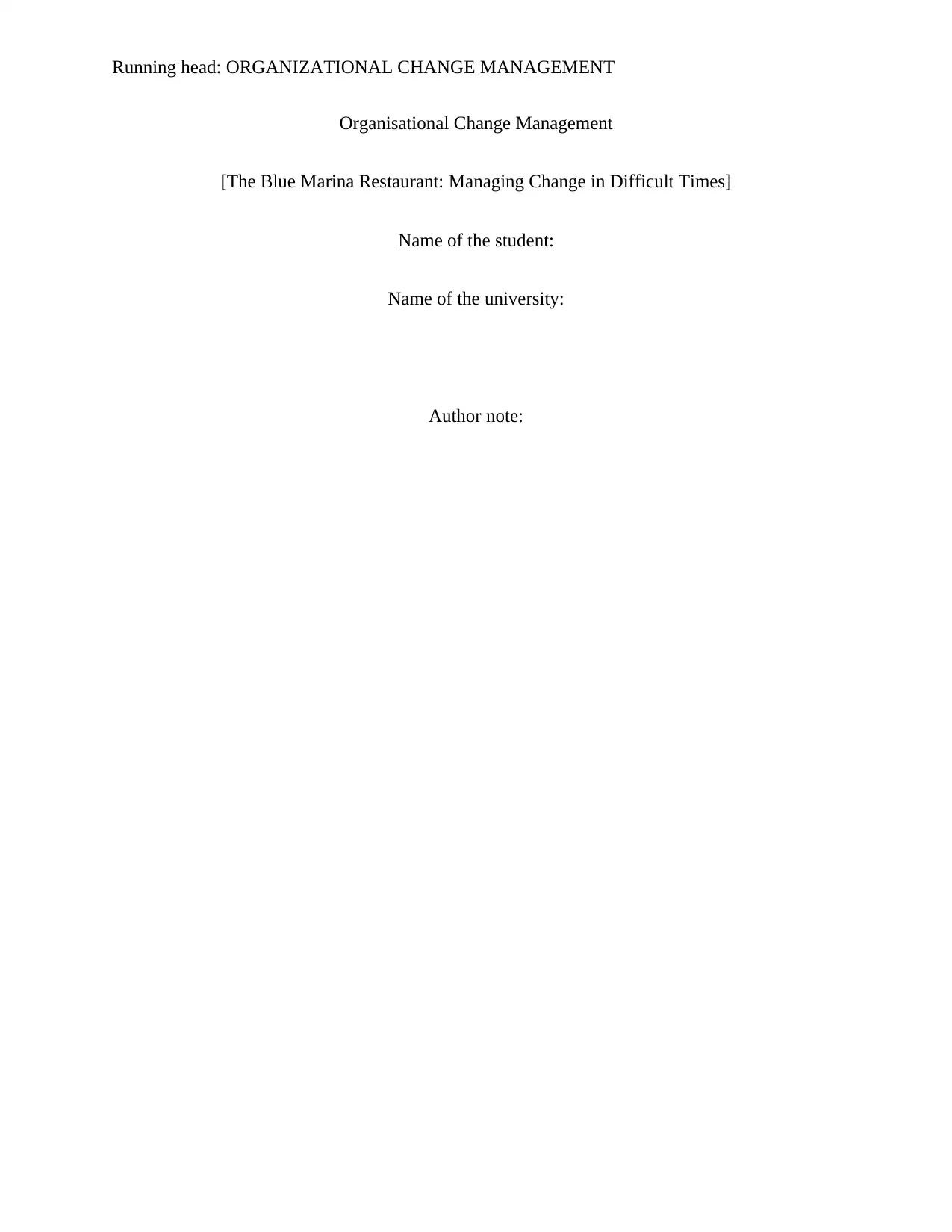
Running head: ORGANIZATIONAL CHANGE MANAGEMENT
Organisational Change Management
[The Blue Marina Restaurant: Managing Change in Difficult Times]
Name of the student:
Name of the university:
Author note:
Organisational Change Management
[The Blue Marina Restaurant: Managing Change in Difficult Times]
Name of the student:
Name of the university:
Author note:
Paraphrase This Document
Need a fresh take? Get an instant paraphrase of this document with our AI Paraphraser
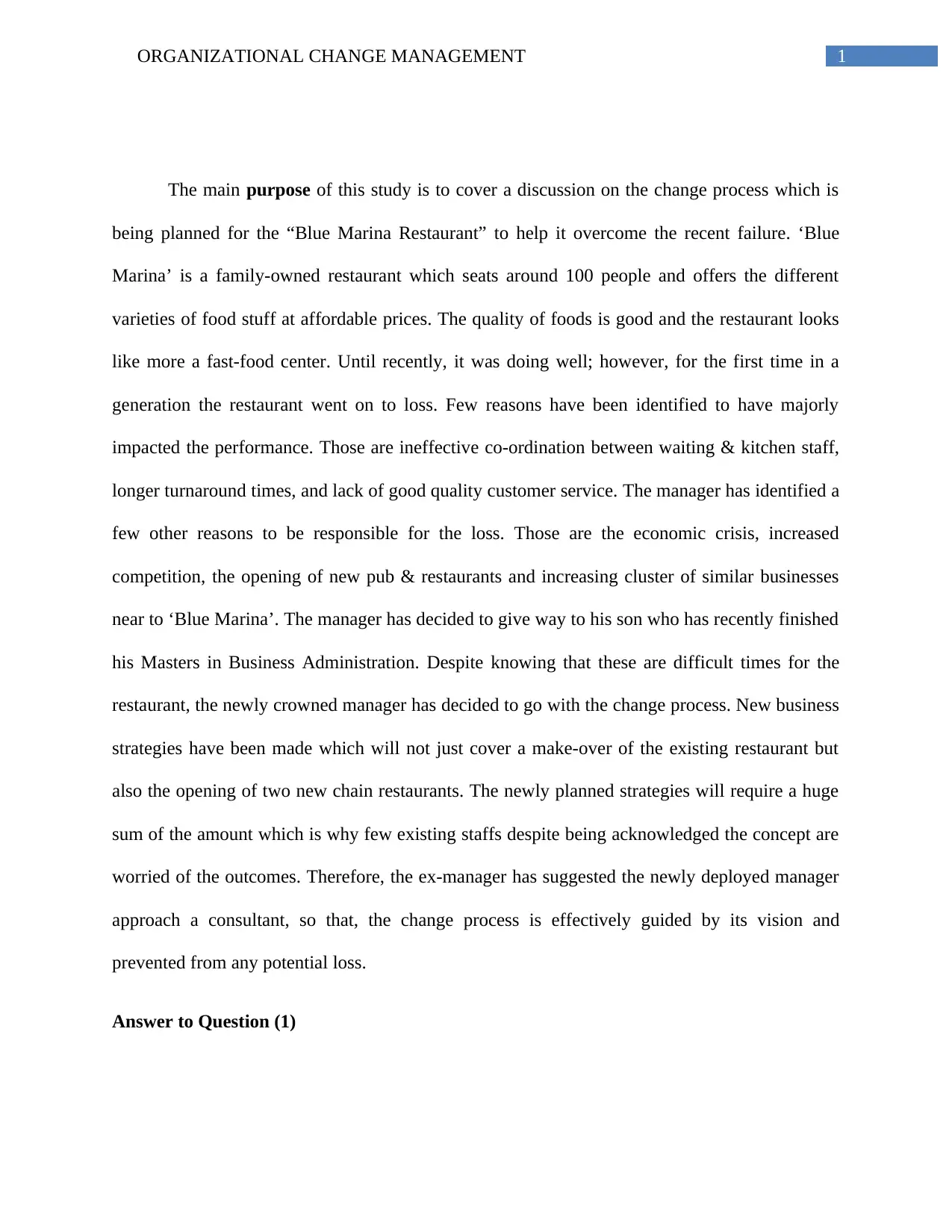
1ORGANIZATIONAL CHANGE MANAGEMENT
The main purpose of this study is to cover a discussion on the change process which is
being planned for the “Blue Marina Restaurant” to help it overcome the recent failure. ‘Blue
Marina’ is a family-owned restaurant which seats around 100 people and offers the different
varieties of food stuff at affordable prices. The quality of foods is good and the restaurant looks
like more a fast-food center. Until recently, it was doing well; however, for the first time in a
generation the restaurant went on to loss. Few reasons have been identified to have majorly
impacted the performance. Those are ineffective co-ordination between waiting & kitchen staff,
longer turnaround times, and lack of good quality customer service. The manager has identified a
few other reasons to be responsible for the loss. Those are the economic crisis, increased
competition, the opening of new pub & restaurants and increasing cluster of similar businesses
near to ‘Blue Marina’. The manager has decided to give way to his son who has recently finished
his Masters in Business Administration. Despite knowing that these are difficult times for the
restaurant, the newly crowned manager has decided to go with the change process. New business
strategies have been made which will not just cover a make-over of the existing restaurant but
also the opening of two new chain restaurants. The newly planned strategies will require a huge
sum of the amount which is why few existing staffs despite being acknowledged the concept are
worried of the outcomes. Therefore, the ex-manager has suggested the newly deployed manager
approach a consultant, so that, the change process is effectively guided by its vision and
prevented from any potential loss.
Answer to Question (1)
The main purpose of this study is to cover a discussion on the change process which is
being planned for the “Blue Marina Restaurant” to help it overcome the recent failure. ‘Blue
Marina’ is a family-owned restaurant which seats around 100 people and offers the different
varieties of food stuff at affordable prices. The quality of foods is good and the restaurant looks
like more a fast-food center. Until recently, it was doing well; however, for the first time in a
generation the restaurant went on to loss. Few reasons have been identified to have majorly
impacted the performance. Those are ineffective co-ordination between waiting & kitchen staff,
longer turnaround times, and lack of good quality customer service. The manager has identified a
few other reasons to be responsible for the loss. Those are the economic crisis, increased
competition, the opening of new pub & restaurants and increasing cluster of similar businesses
near to ‘Blue Marina’. The manager has decided to give way to his son who has recently finished
his Masters in Business Administration. Despite knowing that these are difficult times for the
restaurant, the newly crowned manager has decided to go with the change process. New business
strategies have been made which will not just cover a make-over of the existing restaurant but
also the opening of two new chain restaurants. The newly planned strategies will require a huge
sum of the amount which is why few existing staffs despite being acknowledged the concept are
worried of the outcomes. Therefore, the ex-manager has suggested the newly deployed manager
approach a consultant, so that, the change process is effectively guided by its vision and
prevented from any potential loss.
Answer to Question (1)
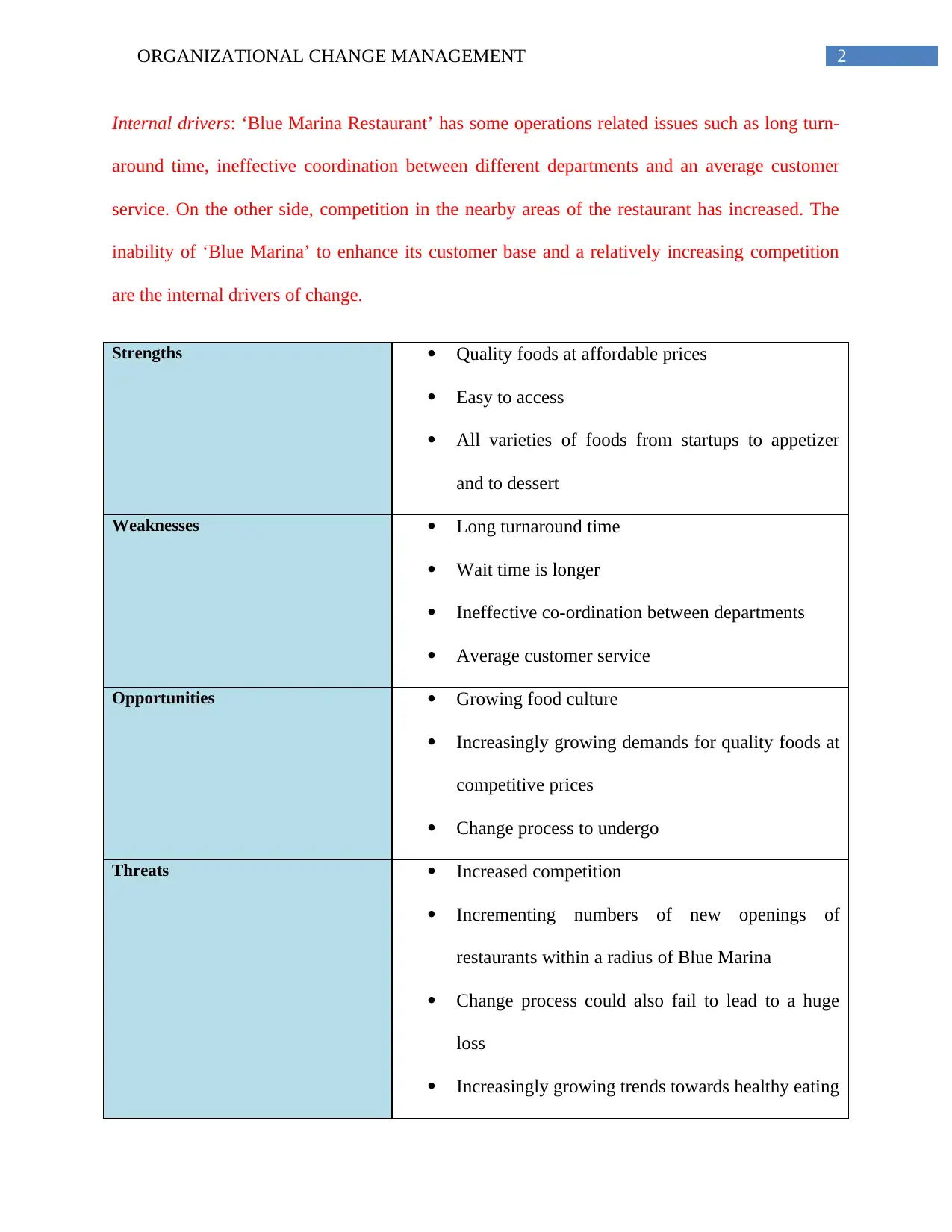
2ORGANIZATIONAL CHANGE MANAGEMENT
Internal drivers: ‘Blue Marina Restaurant’ has some operations related issues such as long turn-
around time, ineffective coordination between different departments and an average customer
service. On the other side, competition in the nearby areas of the restaurant has increased. The
inability of ‘Blue Marina’ to enhance its customer base and a relatively increasing competition
are the internal drivers of change.
Strengths Quality foods at affordable prices
Easy to access
All varieties of foods from startups to appetizer
and to dessert
Weaknesses Long turnaround time
Wait time is longer
Ineffective co-ordination between departments
Average customer service
Opportunities Growing food culture
Increasingly growing demands for quality foods at
competitive prices
Change process to undergo
Threats Increased competition
Incrementing numbers of new openings of
restaurants within a radius of Blue Marina
Change process could also fail to lead to a huge
loss
Increasingly growing trends towards healthy eating
Internal drivers: ‘Blue Marina Restaurant’ has some operations related issues such as long turn-
around time, ineffective coordination between different departments and an average customer
service. On the other side, competition in the nearby areas of the restaurant has increased. The
inability of ‘Blue Marina’ to enhance its customer base and a relatively increasing competition
are the internal drivers of change.
Strengths Quality foods at affordable prices
Easy to access
All varieties of foods from startups to appetizer
and to dessert
Weaknesses Long turnaround time
Wait time is longer
Ineffective co-ordination between departments
Average customer service
Opportunities Growing food culture
Increasingly growing demands for quality foods at
competitive prices
Change process to undergo
Threats Increased competition
Incrementing numbers of new openings of
restaurants within a radius of Blue Marina
Change process could also fail to lead to a huge
loss
Increasingly growing trends towards healthy eating
⊘ This is a preview!⊘
Do you want full access?
Subscribe today to unlock all pages.

Trusted by 1+ million students worldwide
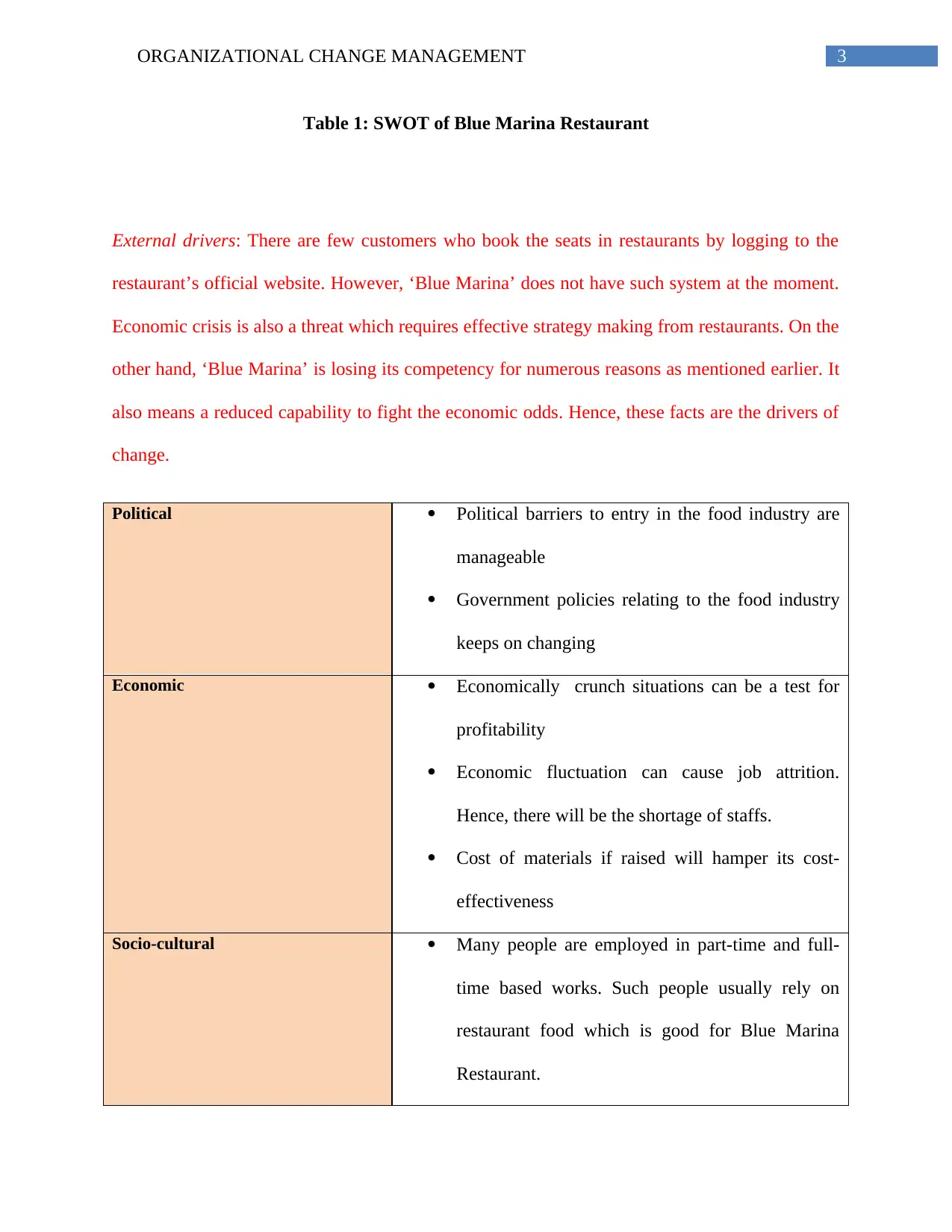
3ORGANIZATIONAL CHANGE MANAGEMENT
Table 1: SWOT of Blue Marina Restaurant
External drivers: There are few customers who book the seats in restaurants by logging to the
restaurant’s official website. However, ‘Blue Marina’ does not have such system at the moment.
Economic crisis is also a threat which requires effective strategy making from restaurants. On the
other hand, ‘Blue Marina’ is losing its competency for numerous reasons as mentioned earlier. It
also means a reduced capability to fight the economic odds. Hence, these facts are the drivers of
change.
Political Political barriers to entry in the food industry are
manageable
Government policies relating to the food industry
keeps on changing
Economic Economically crunch situations can be a test for
profitability
Economic fluctuation can cause job attrition.
Hence, there will be the shortage of staffs.
Cost of materials if raised will hamper its cost-
effectiveness
Socio-cultural Many people are employed in part-time and full-
time based works. Such people usually rely on
restaurant food which is good for Blue Marina
Restaurant.
Table 1: SWOT of Blue Marina Restaurant
External drivers: There are few customers who book the seats in restaurants by logging to the
restaurant’s official website. However, ‘Blue Marina’ does not have such system at the moment.
Economic crisis is also a threat which requires effective strategy making from restaurants. On the
other hand, ‘Blue Marina’ is losing its competency for numerous reasons as mentioned earlier. It
also means a reduced capability to fight the economic odds. Hence, these facts are the drivers of
change.
Political Political barriers to entry in the food industry are
manageable
Government policies relating to the food industry
keeps on changing
Economic Economically crunch situations can be a test for
profitability
Economic fluctuation can cause job attrition.
Hence, there will be the shortage of staffs.
Cost of materials if raised will hamper its cost-
effectiveness
Socio-cultural Many people are employed in part-time and full-
time based works. Such people usually rely on
restaurant food which is good for Blue Marina
Restaurant.
Paraphrase This Document
Need a fresh take? Get an instant paraphrase of this document with our AI Paraphraser
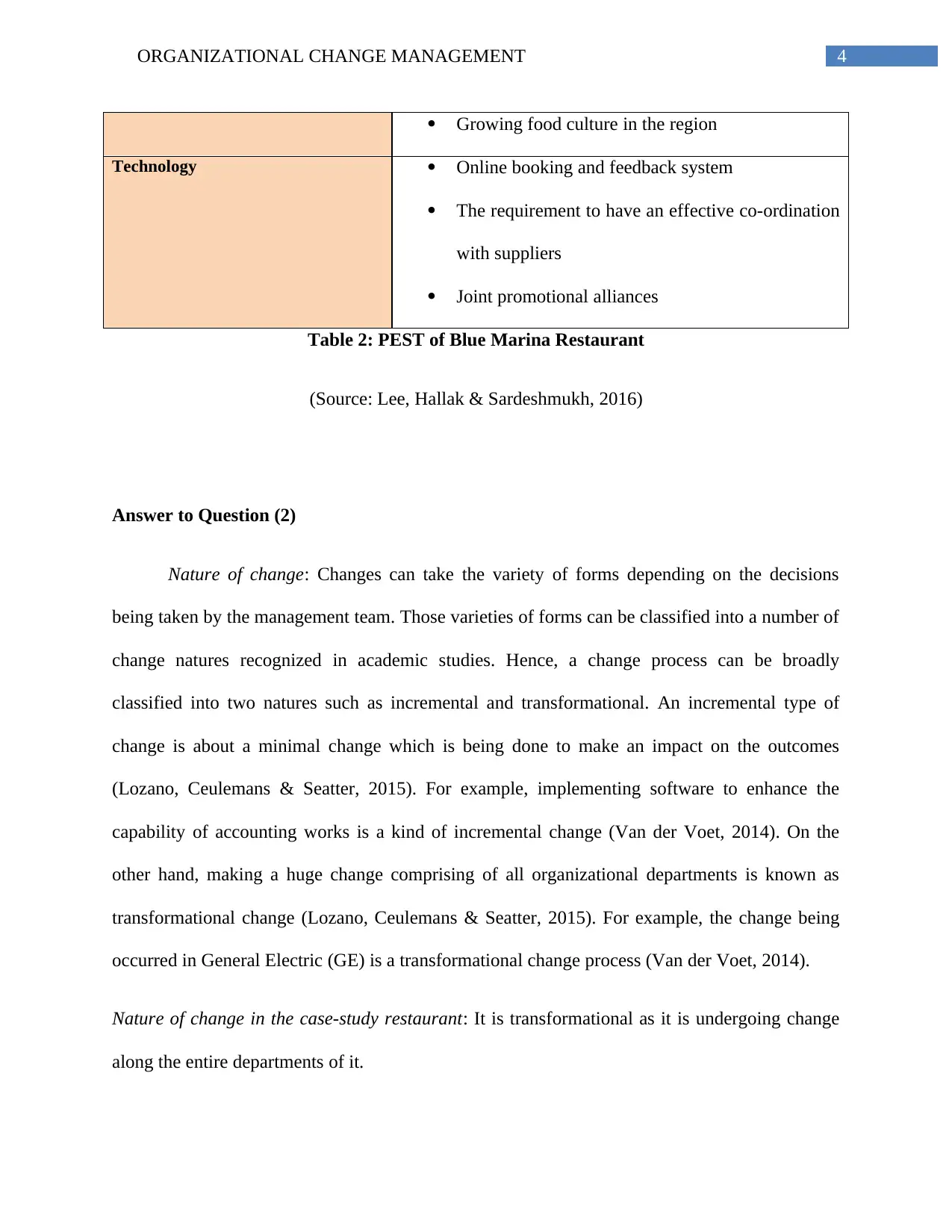
4ORGANIZATIONAL CHANGE MANAGEMENT
Growing food culture in the region
Technology Online booking and feedback system
The requirement to have an effective co-ordination
with suppliers
Joint promotional alliances
Table 2: PEST of Blue Marina Restaurant
(Source: Lee, Hallak & Sardeshmukh, 2016)
Answer to Question (2)
Nature of change: Changes can take the variety of forms depending on the decisions
being taken by the management team. Those varieties of forms can be classified into a number of
change natures recognized in academic studies. Hence, a change process can be broadly
classified into two natures such as incremental and transformational. An incremental type of
change is about a minimal change which is being done to make an impact on the outcomes
(Lozano, Ceulemans & Seatter, 2015). For example, implementing software to enhance the
capability of accounting works is a kind of incremental change (Van der Voet, 2014). On the
other hand, making a huge change comprising of all organizational departments is known as
transformational change (Lozano, Ceulemans & Seatter, 2015). For example, the change being
occurred in General Electric (GE) is a transformational change process (Van der Voet, 2014).
Nature of change in the case-study restaurant: It is transformational as it is undergoing change
along the entire departments of it.
Growing food culture in the region
Technology Online booking and feedback system
The requirement to have an effective co-ordination
with suppliers
Joint promotional alliances
Table 2: PEST of Blue Marina Restaurant
(Source: Lee, Hallak & Sardeshmukh, 2016)
Answer to Question (2)
Nature of change: Changes can take the variety of forms depending on the decisions
being taken by the management team. Those varieties of forms can be classified into a number of
change natures recognized in academic studies. Hence, a change process can be broadly
classified into two natures such as incremental and transformational. An incremental type of
change is about a minimal change which is being done to make an impact on the outcomes
(Lozano, Ceulemans & Seatter, 2015). For example, implementing software to enhance the
capability of accounting works is a kind of incremental change (Van der Voet, 2014). On the
other hand, making a huge change comprising of all organizational departments is known as
transformational change (Lozano, Ceulemans & Seatter, 2015). For example, the change being
occurred in General Electric (GE) is a transformational change process (Van der Voet, 2014).
Nature of change in the case-study restaurant: It is transformational as it is undergoing change
along the entire departments of it.
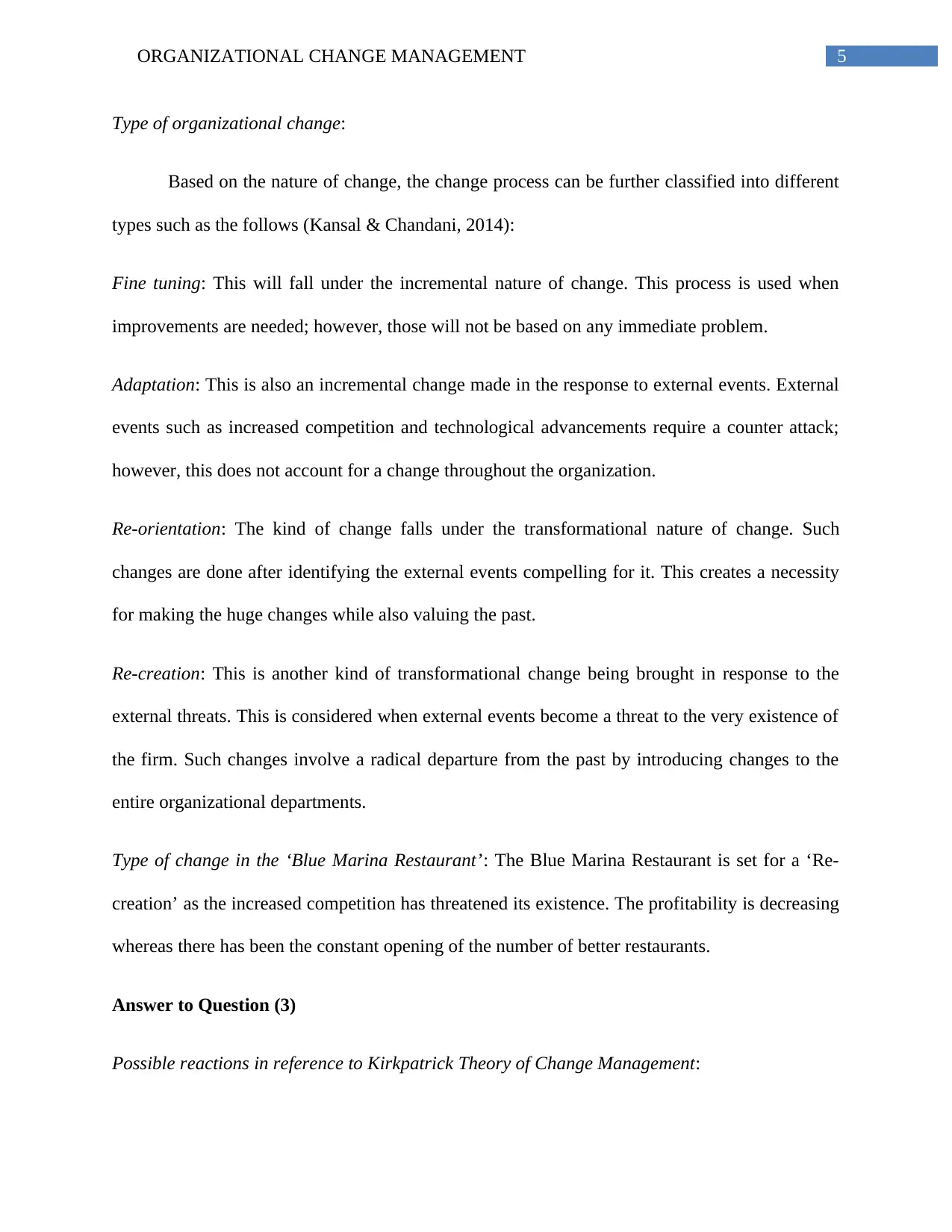
5ORGANIZATIONAL CHANGE MANAGEMENT
Type of organizational change:
Based on the nature of change, the change process can be further classified into different
types such as the follows (Kansal & Chandani, 2014):
Fine tuning: This will fall under the incremental nature of change. This process is used when
improvements are needed; however, those will not be based on any immediate problem.
Adaptation: This is also an incremental change made in the response to external events. External
events such as increased competition and technological advancements require a counter attack;
however, this does not account for a change throughout the organization.
Re-orientation: The kind of change falls under the transformational nature of change. Such
changes are done after identifying the external events compelling for it. This creates a necessity
for making the huge changes while also valuing the past.
Re-creation: This is another kind of transformational change being brought in response to the
external threats. This is considered when external events become a threat to the very existence of
the firm. Such changes involve a radical departure from the past by introducing changes to the
entire organizational departments.
Type of change in the ‘Blue Marina Restaurant’: The Blue Marina Restaurant is set for a ‘Re-
creation’ as the increased competition has threatened its existence. The profitability is decreasing
whereas there has been the constant opening of the number of better restaurants.
Answer to Question (3)
Possible reactions in reference to Kirkpatrick Theory of Change Management:
Type of organizational change:
Based on the nature of change, the change process can be further classified into different
types such as the follows (Kansal & Chandani, 2014):
Fine tuning: This will fall under the incremental nature of change. This process is used when
improvements are needed; however, those will not be based on any immediate problem.
Adaptation: This is also an incremental change made in the response to external events. External
events such as increased competition and technological advancements require a counter attack;
however, this does not account for a change throughout the organization.
Re-orientation: The kind of change falls under the transformational nature of change. Such
changes are done after identifying the external events compelling for it. This creates a necessity
for making the huge changes while also valuing the past.
Re-creation: This is another kind of transformational change being brought in response to the
external threats. This is considered when external events become a threat to the very existence of
the firm. Such changes involve a radical departure from the past by introducing changes to the
entire organizational departments.
Type of change in the ‘Blue Marina Restaurant’: The Blue Marina Restaurant is set for a ‘Re-
creation’ as the increased competition has threatened its existence. The profitability is decreasing
whereas there has been the constant opening of the number of better restaurants.
Answer to Question (3)
Possible reactions in reference to Kirkpatrick Theory of Change Management:
⊘ This is a preview!⊘
Do you want full access?
Subscribe today to unlock all pages.

Trusted by 1+ million students worldwide
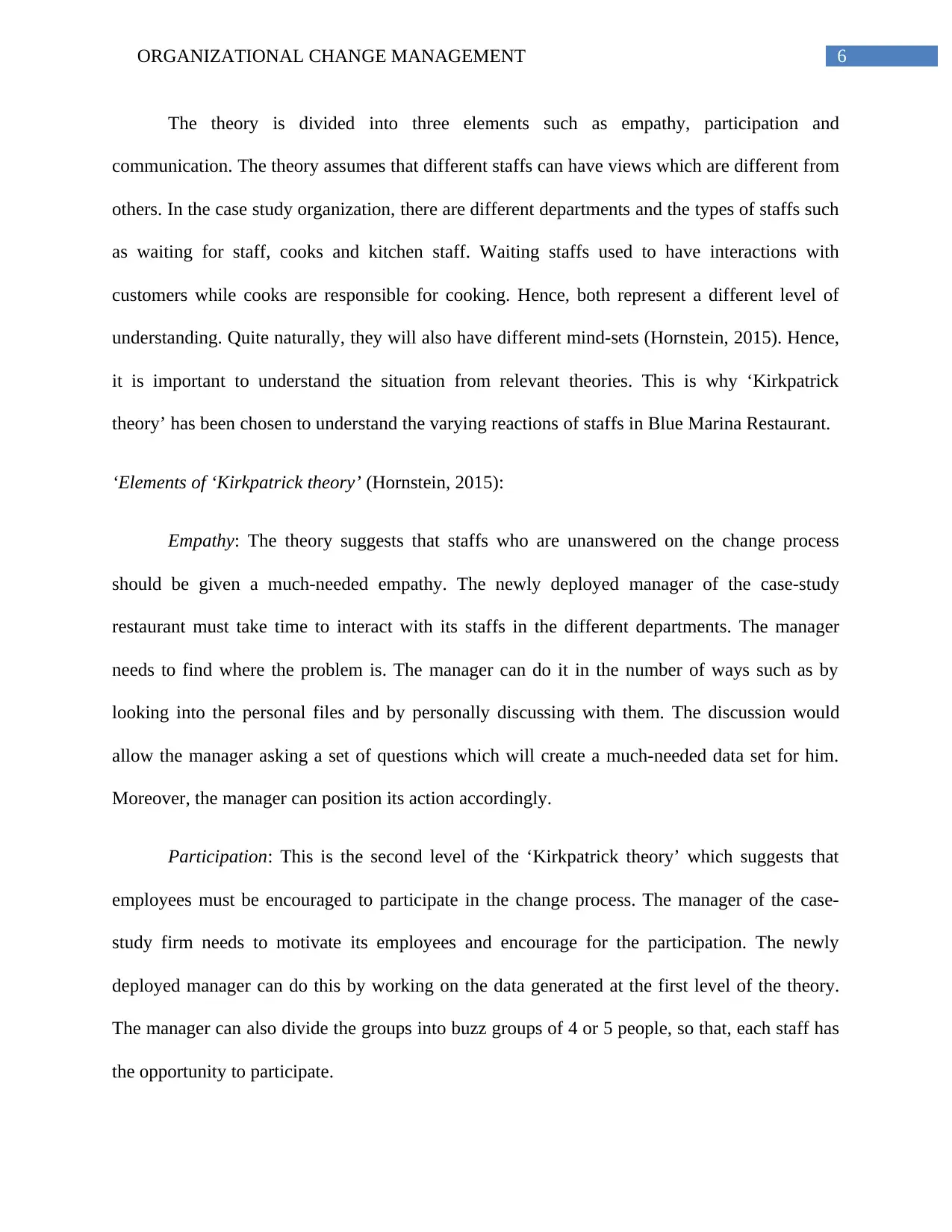
6ORGANIZATIONAL CHANGE MANAGEMENT
The theory is divided into three elements such as empathy, participation and
communication. The theory assumes that different staffs can have views which are different from
others. In the case study organization, there are different departments and the types of staffs such
as waiting for staff, cooks and kitchen staff. Waiting staffs used to have interactions with
customers while cooks are responsible for cooking. Hence, both represent a different level of
understanding. Quite naturally, they will also have different mind-sets (Hornstein, 2015). Hence,
it is important to understand the situation from relevant theories. This is why ‘Kirkpatrick
theory’ has been chosen to understand the varying reactions of staffs in Blue Marina Restaurant.
‘Elements of ‘Kirkpatrick theory’ (Hornstein, 2015):
Empathy: The theory suggests that staffs who are unanswered on the change process
should be given a much-needed empathy. The newly deployed manager of the case-study
restaurant must take time to interact with its staffs in the different departments. The manager
needs to find where the problem is. The manager can do it in the number of ways such as by
looking into the personal files and by personally discussing with them. The discussion would
allow the manager asking a set of questions which will create a much-needed data set for him.
Moreover, the manager can position its action accordingly.
Participation: This is the second level of the ‘Kirkpatrick theory’ which suggests that
employees must be encouraged to participate in the change process. The manager of the case-
study firm needs to motivate its employees and encourage for the participation. The newly
deployed manager can do this by working on the data generated at the first level of the theory.
The manager can also divide the groups into buzz groups of 4 or 5 people, so that, each staff has
the opportunity to participate.
The theory is divided into three elements such as empathy, participation and
communication. The theory assumes that different staffs can have views which are different from
others. In the case study organization, there are different departments and the types of staffs such
as waiting for staff, cooks and kitchen staff. Waiting staffs used to have interactions with
customers while cooks are responsible for cooking. Hence, both represent a different level of
understanding. Quite naturally, they will also have different mind-sets (Hornstein, 2015). Hence,
it is important to understand the situation from relevant theories. This is why ‘Kirkpatrick
theory’ has been chosen to understand the varying reactions of staffs in Blue Marina Restaurant.
‘Elements of ‘Kirkpatrick theory’ (Hornstein, 2015):
Empathy: The theory suggests that staffs who are unanswered on the change process
should be given a much-needed empathy. The newly deployed manager of the case-study
restaurant must take time to interact with its staffs in the different departments. The manager
needs to find where the problem is. The manager can do it in the number of ways such as by
looking into the personal files and by personally discussing with them. The discussion would
allow the manager asking a set of questions which will create a much-needed data set for him.
Moreover, the manager can position its action accordingly.
Participation: This is the second level of the ‘Kirkpatrick theory’ which suggests that
employees must be encouraged to participate in the change process. The manager of the case-
study firm needs to motivate its employees and encourage for the participation. The newly
deployed manager can do this by working on the data generated at the first level of the theory.
The manager can also divide the groups into buzz groups of 4 or 5 people, so that, each staff has
the opportunity to participate.
Paraphrase This Document
Need a fresh take? Get an instant paraphrase of this document with our AI Paraphraser
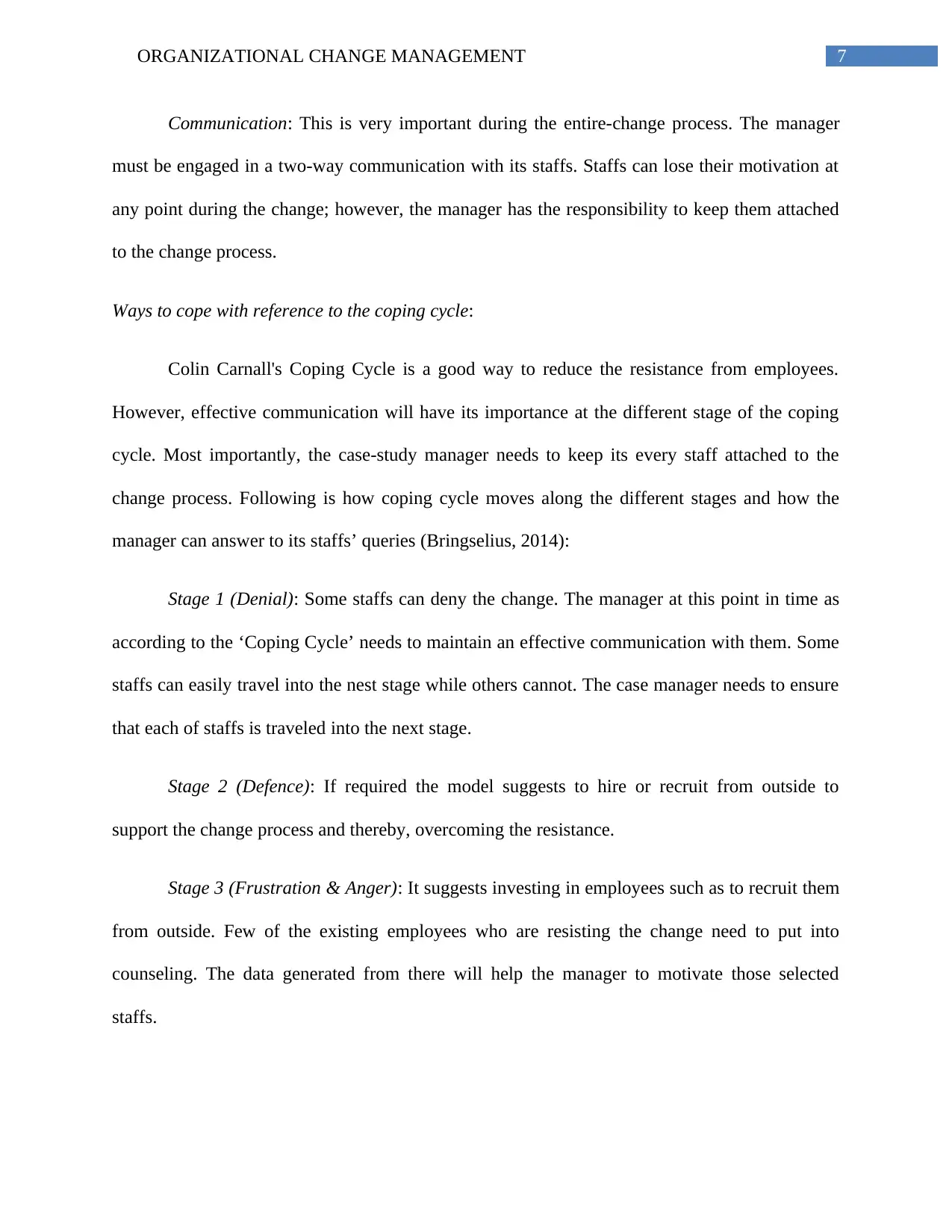
7ORGANIZATIONAL CHANGE MANAGEMENT
Communication: This is very important during the entire-change process. The manager
must be engaged in a two-way communication with its staffs. Staffs can lose their motivation at
any point during the change; however, the manager has the responsibility to keep them attached
to the change process.
Ways to cope with reference to the coping cycle:
Colin Carnall's Coping Cycle is a good way to reduce the resistance from employees.
However, effective communication will have its importance at the different stage of the coping
cycle. Most importantly, the case-study manager needs to keep its every staff attached to the
change process. Following is how coping cycle moves along the different stages and how the
manager can answer to its staffs’ queries (Bringselius, 2014):
Stage 1 (Denial): Some staffs can deny the change. The manager at this point in time as
according to the ‘Coping Cycle’ needs to maintain an effective communication with them. Some
staffs can easily travel into the nest stage while others cannot. The case manager needs to ensure
that each of staffs is traveled into the next stage.
Stage 2 (Defence): If required the model suggests to hire or recruit from outside to
support the change process and thereby, overcoming the resistance.
Stage 3 (Frustration & Anger): It suggests investing in employees such as to recruit them
from outside. Few of the existing employees who are resisting the change need to put into
counseling. The data generated from there will help the manager to motivate those selected
staffs.
Communication: This is very important during the entire-change process. The manager
must be engaged in a two-way communication with its staffs. Staffs can lose their motivation at
any point during the change; however, the manager has the responsibility to keep them attached
to the change process.
Ways to cope with reference to the coping cycle:
Colin Carnall's Coping Cycle is a good way to reduce the resistance from employees.
However, effective communication will have its importance at the different stage of the coping
cycle. Most importantly, the case-study manager needs to keep its every staff attached to the
change process. Following is how coping cycle moves along the different stages and how the
manager can answer to its staffs’ queries (Bringselius, 2014):
Stage 1 (Denial): Some staffs can deny the change. The manager at this point in time as
according to the ‘Coping Cycle’ needs to maintain an effective communication with them. Some
staffs can easily travel into the nest stage while others cannot. The case manager needs to ensure
that each of staffs is traveled into the next stage.
Stage 2 (Defence): If required the model suggests to hire or recruit from outside to
support the change process and thereby, overcoming the resistance.
Stage 3 (Frustration & Anger): It suggests investing in employees such as to recruit them
from outside. Few of the existing employees who are resisting the change need to put into
counseling. The data generated from there will help the manager to motivate those selected
staffs.
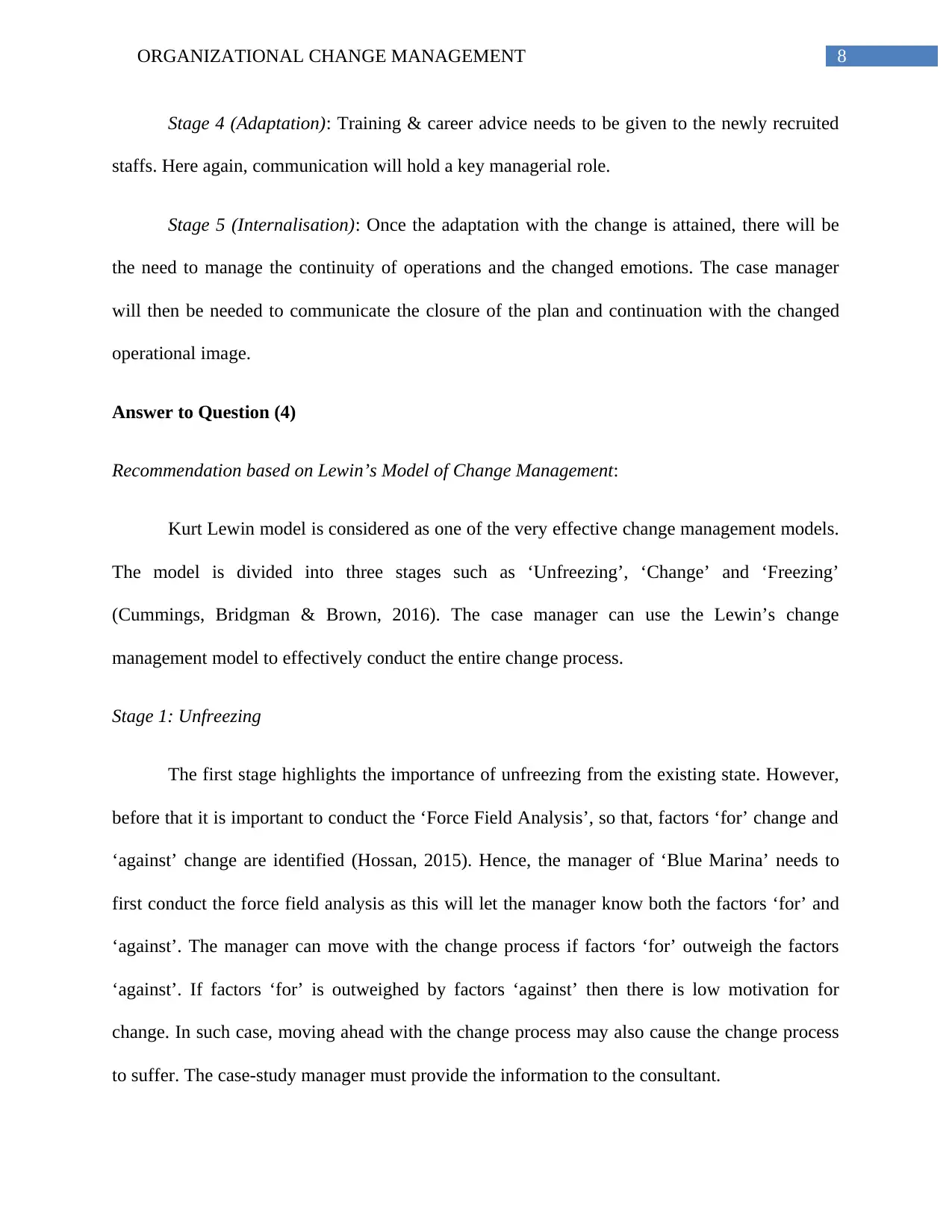
8ORGANIZATIONAL CHANGE MANAGEMENT
Stage 4 (Adaptation): Training & career advice needs to be given to the newly recruited
staffs. Here again, communication will hold a key managerial role.
Stage 5 (Internalisation): Once the adaptation with the change is attained, there will be
the need to manage the continuity of operations and the changed emotions. The case manager
will then be needed to communicate the closure of the plan and continuation with the changed
operational image.
Answer to Question (4)
Recommendation based on Lewin’s Model of Change Management:
Kurt Lewin model is considered as one of the very effective change management models.
The model is divided into three stages such as ‘Unfreezing’, ‘Change’ and ‘Freezing’
(Cummings, Bridgman & Brown, 2016). The case manager can use the Lewin’s change
management model to effectively conduct the entire change process.
Stage 1: Unfreezing
The first stage highlights the importance of unfreezing from the existing state. However,
before that it is important to conduct the ‘Force Field Analysis’, so that, factors ‘for’ change and
‘against’ change are identified (Hossan, 2015). Hence, the manager of ‘Blue Marina’ needs to
first conduct the force field analysis as this will let the manager know both the factors ‘for’ and
‘against’. The manager can move with the change process if factors ‘for’ outweigh the factors
‘against’. If factors ‘for’ is outweighed by factors ‘against’ then there is low motivation for
change. In such case, moving ahead with the change process may also cause the change process
to suffer. The case-study manager must provide the information to the consultant.
Stage 4 (Adaptation): Training & career advice needs to be given to the newly recruited
staffs. Here again, communication will hold a key managerial role.
Stage 5 (Internalisation): Once the adaptation with the change is attained, there will be
the need to manage the continuity of operations and the changed emotions. The case manager
will then be needed to communicate the closure of the plan and continuation with the changed
operational image.
Answer to Question (4)
Recommendation based on Lewin’s Model of Change Management:
Kurt Lewin model is considered as one of the very effective change management models.
The model is divided into three stages such as ‘Unfreezing’, ‘Change’ and ‘Freezing’
(Cummings, Bridgman & Brown, 2016). The case manager can use the Lewin’s change
management model to effectively conduct the entire change process.
Stage 1: Unfreezing
The first stage highlights the importance of unfreezing from the existing state. However,
before that it is important to conduct the ‘Force Field Analysis’, so that, factors ‘for’ change and
‘against’ change are identified (Hossan, 2015). Hence, the manager of ‘Blue Marina’ needs to
first conduct the force field analysis as this will let the manager know both the factors ‘for’ and
‘against’. The manager can move with the change process if factors ‘for’ outweigh the factors
‘against’. If factors ‘for’ is outweighed by factors ‘against’ then there is low motivation for
change. In such case, moving ahead with the change process may also cause the change process
to suffer. The case-study manager must provide the information to the consultant.
⊘ This is a preview!⊘
Do you want full access?
Subscribe today to unlock all pages.

Trusted by 1+ million students worldwide
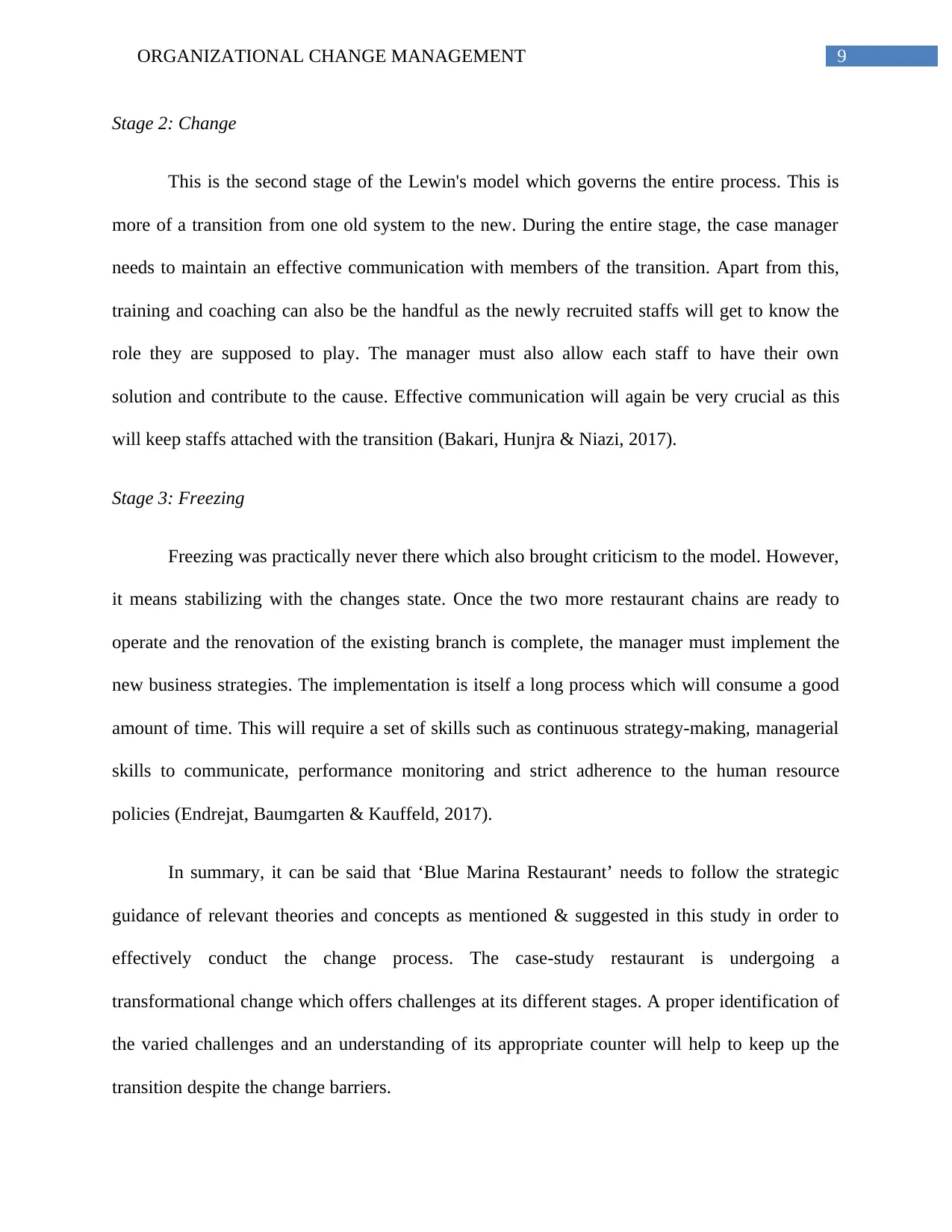
9ORGANIZATIONAL CHANGE MANAGEMENT
Stage 2: Change
This is the second stage of the Lewin's model which governs the entire process. This is
more of a transition from one old system to the new. During the entire stage, the case manager
needs to maintain an effective communication with members of the transition. Apart from this,
training and coaching can also be the handful as the newly recruited staffs will get to know the
role they are supposed to play. The manager must also allow each staff to have their own
solution and contribute to the cause. Effective communication will again be very crucial as this
will keep staffs attached with the transition (Bakari, Hunjra & Niazi, 2017).
Stage 3: Freezing
Freezing was practically never there which also brought criticism to the model. However,
it means stabilizing with the changes state. Once the two more restaurant chains are ready to
operate and the renovation of the existing branch is complete, the manager must implement the
new business strategies. The implementation is itself a long process which will consume a good
amount of time. This will require a set of skills such as continuous strategy-making, managerial
skills to communicate, performance monitoring and strict adherence to the human resource
policies (Endrejat, Baumgarten & Kauffeld, 2017).
In summary, it can be said that ‘Blue Marina Restaurant’ needs to follow the strategic
guidance of relevant theories and concepts as mentioned & suggested in this study in order to
effectively conduct the change process. The case-study restaurant is undergoing a
transformational change which offers challenges at its different stages. A proper identification of
the varied challenges and an understanding of its appropriate counter will help to keep up the
transition despite the change barriers.
Stage 2: Change
This is the second stage of the Lewin's model which governs the entire process. This is
more of a transition from one old system to the new. During the entire stage, the case manager
needs to maintain an effective communication with members of the transition. Apart from this,
training and coaching can also be the handful as the newly recruited staffs will get to know the
role they are supposed to play. The manager must also allow each staff to have their own
solution and contribute to the cause. Effective communication will again be very crucial as this
will keep staffs attached with the transition (Bakari, Hunjra & Niazi, 2017).
Stage 3: Freezing
Freezing was practically never there which also brought criticism to the model. However,
it means stabilizing with the changes state. Once the two more restaurant chains are ready to
operate and the renovation of the existing branch is complete, the manager must implement the
new business strategies. The implementation is itself a long process which will consume a good
amount of time. This will require a set of skills such as continuous strategy-making, managerial
skills to communicate, performance monitoring and strict adherence to the human resource
policies (Endrejat, Baumgarten & Kauffeld, 2017).
In summary, it can be said that ‘Blue Marina Restaurant’ needs to follow the strategic
guidance of relevant theories and concepts as mentioned & suggested in this study in order to
effectively conduct the change process. The case-study restaurant is undergoing a
transformational change which offers challenges at its different stages. A proper identification of
the varied challenges and an understanding of its appropriate counter will help to keep up the
transition despite the change barriers.
Paraphrase This Document
Need a fresh take? Get an instant paraphrase of this document with our AI Paraphraser

10ORGANIZATIONAL CHANGE MANAGEMENT
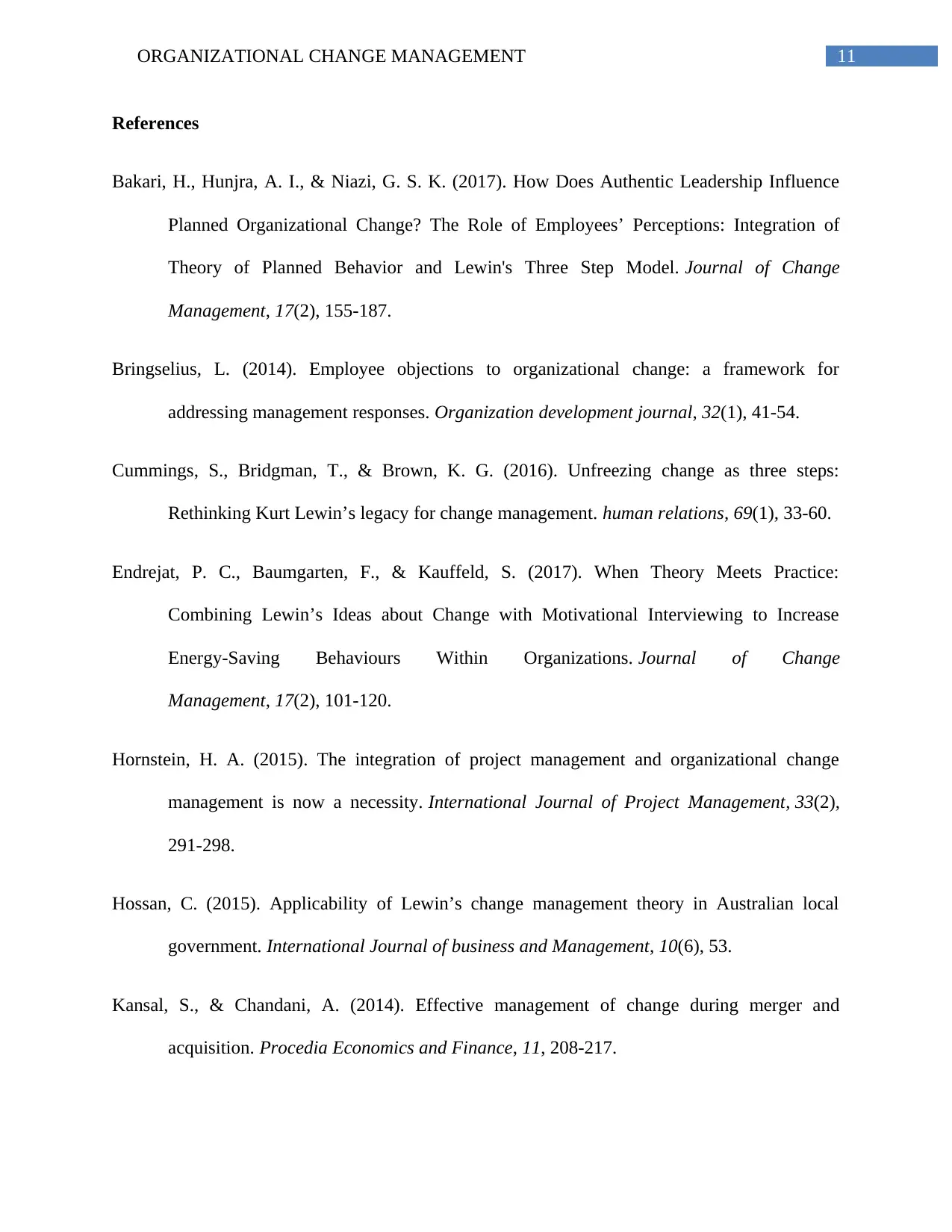
11ORGANIZATIONAL CHANGE MANAGEMENT
References
Bakari, H., Hunjra, A. I., & Niazi, G. S. K. (2017). How Does Authentic Leadership Influence
Planned Organizational Change? The Role of Employees’ Perceptions: Integration of
Theory of Planned Behavior and Lewin's Three Step Model. Journal of Change
Management, 17(2), 155-187.
Bringselius, L. (2014). Employee objections to organizational change: a framework for
addressing management responses. Organization development journal, 32(1), 41-54.
Cummings, S., Bridgman, T., & Brown, K. G. (2016). Unfreezing change as three steps:
Rethinking Kurt Lewin’s legacy for change management. human relations, 69(1), 33-60.
Endrejat, P. C., Baumgarten, F., & Kauffeld, S. (2017). When Theory Meets Practice:
Combining Lewin’s Ideas about Change with Motivational Interviewing to Increase
Energy-Saving Behaviours Within Organizations. Journal of Change
Management, 17(2), 101-120.
Hornstein, H. A. (2015). The integration of project management and organizational change
management is now a necessity. International Journal of Project Management, 33(2),
291-298.
Hossan, C. (2015). Applicability of Lewin’s change management theory in Australian local
government. International Journal of business and Management, 10(6), 53.
Kansal, S., & Chandani, A. (2014). Effective management of change during merger and
acquisition. Procedia Economics and Finance, 11, 208-217.
References
Bakari, H., Hunjra, A. I., & Niazi, G. S. K. (2017). How Does Authentic Leadership Influence
Planned Organizational Change? The Role of Employees’ Perceptions: Integration of
Theory of Planned Behavior and Lewin's Three Step Model. Journal of Change
Management, 17(2), 155-187.
Bringselius, L. (2014). Employee objections to organizational change: a framework for
addressing management responses. Organization development journal, 32(1), 41-54.
Cummings, S., Bridgman, T., & Brown, K. G. (2016). Unfreezing change as three steps:
Rethinking Kurt Lewin’s legacy for change management. human relations, 69(1), 33-60.
Endrejat, P. C., Baumgarten, F., & Kauffeld, S. (2017). When Theory Meets Practice:
Combining Lewin’s Ideas about Change with Motivational Interviewing to Increase
Energy-Saving Behaviours Within Organizations. Journal of Change
Management, 17(2), 101-120.
Hornstein, H. A. (2015). The integration of project management and organizational change
management is now a necessity. International Journal of Project Management, 33(2),
291-298.
Hossan, C. (2015). Applicability of Lewin’s change management theory in Australian local
government. International Journal of business and Management, 10(6), 53.
Kansal, S., & Chandani, A. (2014). Effective management of change during merger and
acquisition. Procedia Economics and Finance, 11, 208-217.
⊘ This is a preview!⊘
Do you want full access?
Subscribe today to unlock all pages.

Trusted by 1+ million students worldwide
1 out of 13
Related Documents
Your All-in-One AI-Powered Toolkit for Academic Success.
+13062052269
info@desklib.com
Available 24*7 on WhatsApp / Email
![[object Object]](/_next/static/media/star-bottom.7253800d.svg)
Unlock your academic potential
Copyright © 2020–2025 A2Z Services. All Rights Reserved. Developed and managed by ZUCOL.





